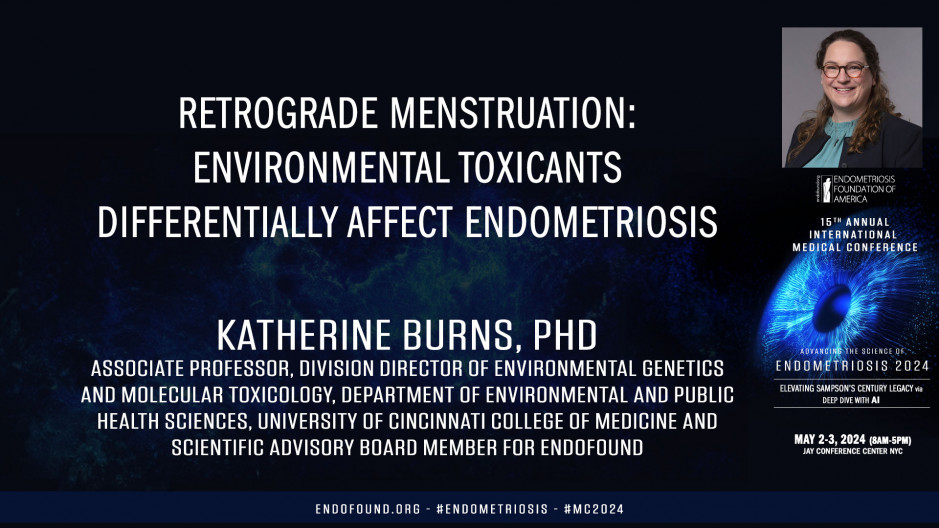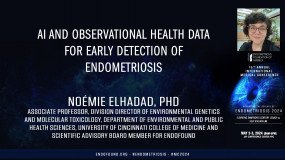International Medical Conference
Endometriosis 2024:
Elevating Sampson’s Century Legacy via
Deep Dive with AI
For the benefit of Endometriosis Foundation of America (EndoFound)
May 2-3, 2024 - JAY CENTER (Paris Room) - NYC
But welcome everybody and thank you for being part of the session. Can you hear me okay? Okay, great. So exactly what Dr. Al Hadid said, that's what we're going to be talking about today. But first, we use a mouse model in my lab. And one of the things that I wanted to talk about and really go over is the mouse model, because I was part of a consortium with the World Endometriosis Research Foundation over the last couple of years where we really talked about the importance of the models and what we're studying and how we're studying it. So what I want to point out to you is this is what human peritoneal fluid looks like in a woman with endometriosis. These macrophages are highly activated. There are a lot of red blood cells and there are a lot of neutrophils that are infiltrating into the peritoneal cavity.
Oh, wrong way. So with our mouse model, what we really tried to do is look at a sham model, a sham mouse where the animal received the same surgery as an endometriosis animal, but the animal only received saline in the fluid or PBS. So we can see that there are macrophages and neutrophils in all of these immune cells present in the peritoneal cavity. However, with endometriosis in the endometriosis mouse, we now see these increased activated macrophages, increased recruitment of neutrophils, very similar to what we see in the human peritoneal fluid. So what we also did, because there were a lot of naysayers out there, and I was one of them myself, and I was actually terrified to do this experiment. But what we did is we injected uterus, mammary gland, bladder, and lung into the peritoneal cavity. Why is it not moving?
They did tell me it was slow. So we injected uterus, bladder, mammary, gland, and lung into the peritoneal cavity. I apologize. And if you look at this slide, it's not going to show you the graph, but what we found, no, maybe that's a good idea. Okay. And the graph that I have here is not converted over. So hopefully the rest of my slides will actually be here. But what we found is that only the uterus attached and developed a blood supply and not shown over here. On this side of the figure is where we actually treated the animals with and without estrogen. We've had them overact and added back estrogen, and we found that none of the other pieces of tissue actually attached to developed lesions. So it's definitely from the uterus. Do you have a question? We don't have to. Nope. They float around and we had to collect them to be able to photograph them from this.
And a lot of information that I'm not showing you in the presentation, we look at endometriosis as two different phases. We look at the initiation phase, which seems to be immune predominant, specifically the macrophages, neutrophils, NK cells, a lot of chemokines, cytokines and growth factors. And then the progressive phase of endometriosis, which is hormone predominant. So what we're here to look at in question today is looking at environmental toxicants and how they contribute to the initiation and or progression of disease. And our first set of experiments years ago really focused on bisphenol A. This was one of the most talked about topics at the time when we started this with looking at these endocrine disrupting chemicals with the bisphenols. And there are now bisphenol a, a lot of different products are bisphenol a free, and I'm showing you up here on the top is what bisphenol A looks like.
And bisphenol AF has the fluorinated compounds or fluorinated chemicals on the side of the element on the side of the compound. This phenol AF actually makes this much more stable and studies have shown that it makes it more estrogenic. So there's actually some studies that have been done by Leonardo Trand here in New York actually, and he's a phenomenal speaker. And what he's done with some of his epidemiological research is looked at what are called regrettable substitutions. So in our initial hard clear plastic water bottles was BPA, they've now made these regrettable substitutions. They're actually worse for us than the original compound. So these cogen are suggested to be more estrogenic. And we looked at this in our mouse model.
Oh no, none of my graphs are going to show up. So let me explain to you what is not on the slide. So what we did is we took animals that were over optimiz or intact. And what we found is by looking at the number of lesions that the animals formed, all of the animals, whether we treated them with BPA at three different concentrations or with BPAF at three different concentrations, and it compared it to hanal estradiol as our positive control, we found that all mice over optimiz or intact develop the same number of lesions. So really it's not an estrogen mediated dependent activation of the initiation of disease. However, we then looked at the same data set where we were looking at what happens to the lesions? Do they grow, do they progress? And we actually find that in the overact ized mice, the estrogenic properties of the BPA and the BPAF are much stronger than they are in the over ized mice.
I'm sorry, in the intact mice. However, what we found is in the intact mice, lower levels of the toxicants had more of an effect than the higher levels of the toxicant. Okay, so let's move on to our next topic, which is the initiation. And with this, this is the work that we were able actually to do with the help of a grant that we got through the endometriosis foundation. And this was looking at our first immunotoxin, which is phthalates. So dylex phthalates, these are found in higher urinary plasma concentrations in women with endometriosis. They make plastics more flexible. They're found in a lot of these medical supplies, plastic wraps, A lot of the new flooring that people are putting out and about with the Perla, they are listed simply as fragrance because they're not FDA approved. They're listed as fragrance in a lot of the products that we use.
And a couple of years ago, a group, actually they're in New York City as well, looked at phthalate concentrations in a number of products that are predominantly used by women during menstruation. So pads, pant liners, tampons and wipes, and find that there are levels of different phthalates that are present within these products. And there are an abundance of the high molecular weight and the low molecular weight phthalates. And again, through some series of research that I'm not showing you, one of the pathways that we chose to focus on was IL six signaling. So IL six signals through both a classical and trans signaling. And so what we wanted to do is look at the uterus after phthalate treatment. And we found, if we look at IL six, and this is a very messy antibody, and what we found is there's an increase in IL six receptor alpha and specifically the soluble IL six receptor alpha.
So trans signaling occurs through soluble IL six receptor alpha, then binding to GP one 30. GP one 30 is bound in most of all of our cells. And interestingly soluble G one 30 X as an inhibitory complex with the IL six receptor alpha. So when this is missing and this is added, we see the trans signaling. So we wanted to then ask, and I think my graph is going to show up. Yes. So then we wanted to ask, I'm thrilled by this. So then we wanted to ask what happens with lesion number with and without pH? So it's typical. We see that we get about five lesions per mouse that develop and with phthalates, this was huge for me when we did this a few years ago, because no matter what we did with anything estrogenic, we were not seeing any increase in lesion development.
So anytime we modulate the immune system, we're now seeing this increase in lesion number to go backwards a little bit and to look to see where this might be occurring and what might be playing a role. We looked very early. So this is 48 hours after the injection of uterine tissue or endometrium into the peritoneal cavity. And what we find just at the baseline level is looking at LI six G for neutrophils with DEHP treatment. And we see an increase. But more importantly, with the endometriosis, specifically with neutrophils, we see higher recruitment of neutrophils to the peritoneal cavity. And this is mirrored with monocytes as well. And we would also predict macrophages that I'm not showing you. So the next step that we took was we worked with Stephan Rose John in Germany. He's now since retired his, so GP one 30 has actually been purchased now by a company as a marketable for colitis.
So if we look at what we found as a lesion number, we treated these animals with and without DEHP, and then we treated them with soluble GP one 30, which blocks specifically trans signaling only. And we then blocked all of IL six receptor signaling. So what's very interestingly shown is exactly what we saw before where we saw the increase in lesion number with DEHP treatment. However, this is almost significant where we see almost significant decrease in lesion number with the trans signaling blockage through soluble GP one 30, the increase by DEHP is completely blocked. And however, this is what we also saw with the IL six knockout animal as well, is there seems to be some sort of a tilting of the trans versus classical signaling, and it's completely blocking that response. And we're seeing more lesions that are found, and that's even more exacerbated with the DEHP treatment.
So the next step in our newest set of research that we want to delve into, and the focus really where N-I-E-H-S is focusing are on the Pero Quinol, nces, excuse me, or the PFOS, where there are greater than 12,000 chemicals. If you go ahead and look at what is shown over here, you can see that it is shown and found in tremendous amount of products. These chemicals have stain stick and water resistant properties. They're considered forever chemicals because they're persistent and have long half-lifes. But what scared me and why I started to look into this is last fall a group there was a working group and they had the University of Notre Dame look at these actual period products and period products were tested for the potential levels of PFAS. So what they found is that every single product tested indicated at least trace amounts of these PFAS substances.
20% of them had unintentionally high levels of PFAS because they weren't added to the product. 20% of them actually had added PFAS chemicals intentionally and those being tampons pads and liners. And what I found to be even more alarming is that 25% of the period underwear, the newest and greatest thing on the market has very high levels of these pfos, which makes sense because of the stick proof, the leak proof, all of that. But it's not comforting that these are what are being absorbed into our body. So from this, what we did is we worked with team at University of Cincinnati where I am and also Cincinnati Children's Hospital where they have a cohort of girls. It's called Growing Up Female. And in that cohort, they followed a large number of girls from infancy all the way through puberty into adulthood. And they're looking at a number of environmental toxicants and compounds that are presented in their serum and urine.
So what we did is we looked at the data retrospectively and we asked, is there anything that is showing in this dataset? So looking specifically at POA, we asked these girls, or they asked the girls, I didn't personally, but they asked the girls if they had cramping on day one of their period. And if you look at this, we see a significant increase in the yes answer as the increase in PFOA gets higher in the serum of these girls. So from that, our next question was what does this do in our mouse model? And we chose to look at both PFOA and PF os, which are two very similar, but different PFAS chemicals. And what we find as we would expect, because we proposed or hypothesized that this would be our more immunotoxic, PFOA was more toxic of the P FFO ss. And that's exactly what we find as we see a high number of lesions that are formed in these animals.
And interestingly, what we're seeing mimics the human data when asked and to look at PFOS, there's no change in the yes no cramping and P FFO S. And we see really no differences in the lesion number that are formed with PFOS to take a look into this and look deeper as what's happening in the peritoneal cavity. This is actually looking six weeks after the animals have been given endometriosis. So a lot of the acute inflammatory response has calmed down and should have been calmed down by this point. And this is shown with the vehicle peritoneal fluid where we do see activated macrophages and recruitment of few neutrophils. But some of these macrophages are still activated, but they're calmed down, if you will, compared to the POA macrophages. These macrophages are very activated, and as we say in my lab, they're angry macrophages is what we have.
We see less of these angry macrophages and the P FFO S group, which mimics the lesion number. And if we look then more specifically to what is specifically recruited as far as macrophages into these lesions, we have our vehicle lesions in the purple, the dark purple is the immunohistochemistry for F four 80 for macrophages. We see that we do have macrophages present in, excuse me, in the lesions as we would expect. But if you look at the PFOA lesions, we have much higher recruitment of those macrophages into those lesions. And there is less with PFAS. So we have this grant submitted to study section and hopefully we'll reviewed favorably in the next coming weeks. But we're quite excited by how well the correlation between the human data and the animal data really correspond. So with that, I don't know how much time I have left, but two minutes.
Okay. So I'm doing okay. So the question is then do these environmental toxicants contribute to the progression or the initiation of endometriosis? My thought is yes, there is some kind of a contribution, and I believe that that has more to do with a gene environment interaction, that something about my genes versus something about your genes may have an effect and may play a role in what's really driving some of these disease phenotypes. And what's interesting to me is that these cogens of different toxicants actually play different roles. And I think as we dive deeper into understanding what we're exposed to, what different groups of people are exposed to and how they're exposed, this really may play a role in understanding more about disease and helping us understand the inflammatory responses and how to decrease some of the inflammation that is present in our bodies. So the next slide I have is just my acknowledgements, where I want to specifically thank the people that are in my lab right now, the past lab members, the funding that I've had over a number of years, but specifically with the Endometriosis Foundation, which really helped spark the start of the Immunotoxic projects and hopefully will lead us into new areas.
And Ishi is waiting for us, so lead us into new areas of research. And as asked by Dan, I have my references that anybody can look up and see online. So thank you all very much.
I.










